Positive and Negative Frequencies
In §2.9, we used Euler's Identity to show

Setting
![]() , we see that both sine and cosine (and
hence all real sinusoids) consist of a sum of equal and opposite circular
motion. Phrased differently, every real sinusoid consists of an equal
contribution of positive and negative frequency components. This is true
of all real signals. When we get to spectrum analysis, we will find that
every real signal contains equal amounts of positive and negative
frequencies, i.e., if
, we see that both sine and cosine (and
hence all real sinusoids) consist of a sum of equal and opposite circular
motion. Phrased differently, every real sinusoid consists of an equal
contribution of positive and negative frequency components. This is true
of all real signals. When we get to spectrum analysis, we will find that
every real signal contains equal amounts of positive and negative
frequencies, i.e., if ![]() denotes the spectrum of the real signal
denotes the spectrum of the real signal
![]() , we will always have
, we will always have
![]() .
.
Note that, mathematically, the complex sinusoid
![]() is really simpler and more basic than the real
sinusoid
is really simpler and more basic than the real
sinusoid
![]() because
because
![]() consists of
one frequency
consists of
one frequency ![]() while
while
![]() really consists of two
frequencies
really consists of two
frequencies ![]() and
and ![]() . We may think of a real sinusoid
as being the sum of a positive-frequency and a negative-frequency
complex sinusoid, so in that sense real sinusoids are ``twice as
complicated'' as complex sinusoids. Complex sinusoids are also nicer
because they have a constant modulus. ``Amplitude envelope
detectors'' for complex sinusoids are trivial: just compute the square
root of the sum of the squares of the real and imaginary parts to
obtain the instantaneous peak amplitude at any time. Frequency
demodulators are similarly trivial: just differentiate the phase of
the complex sinusoid to obtain its instantaneous frequency. It
should therefore come as no surprise that signal processing engineers
often prefer to convert real sinusoids into complex sinusoids (by
filtering out the negative-frequency component) before processing them
further.
. We may think of a real sinusoid
as being the sum of a positive-frequency and a negative-frequency
complex sinusoid, so in that sense real sinusoids are ``twice as
complicated'' as complex sinusoids. Complex sinusoids are also nicer
because they have a constant modulus. ``Amplitude envelope
detectors'' for complex sinusoids are trivial: just compute the square
root of the sum of the squares of the real and imaginary parts to
obtain the instantaneous peak amplitude at any time. Frequency
demodulators are similarly trivial: just differentiate the phase of
the complex sinusoid to obtain its instantaneous frequency. It
should therefore come as no surprise that signal processing engineers
often prefer to convert real sinusoids into complex sinusoids (by
filtering out the negative-frequency component) before processing them
further.
Next Section:
Plotting Complex Sinusoids versus Frequency
Previous Section:
Projection of Circular Motion



















